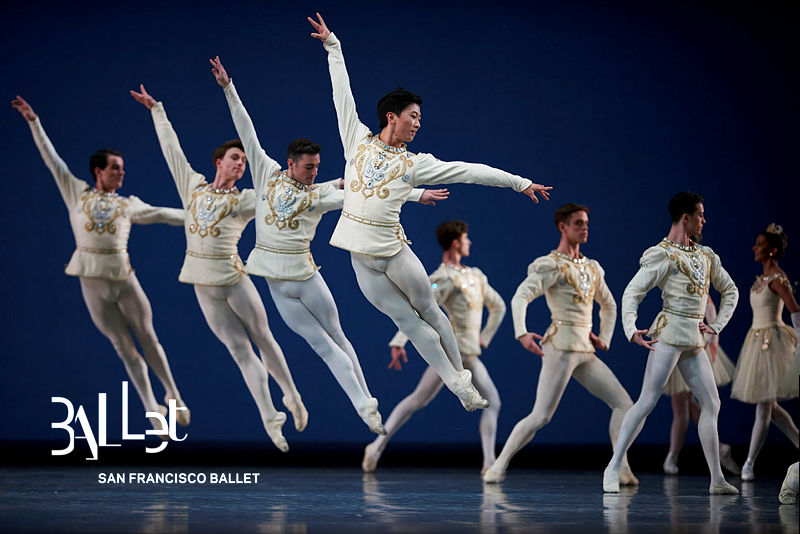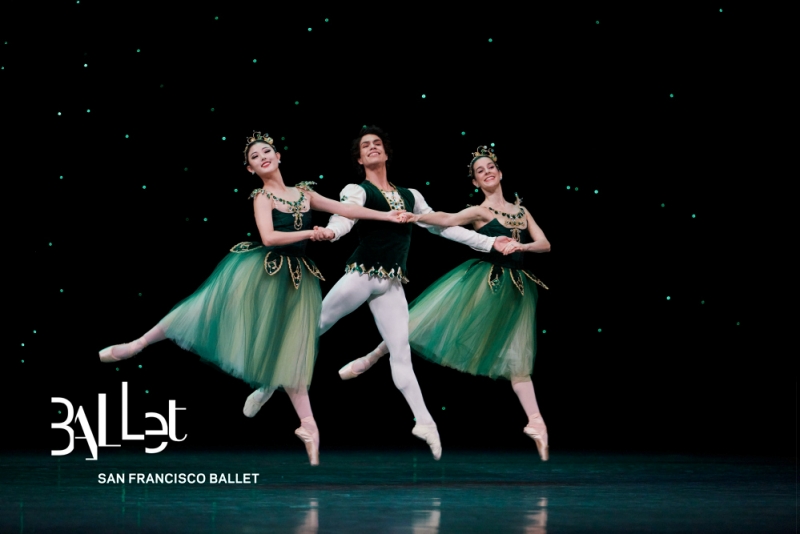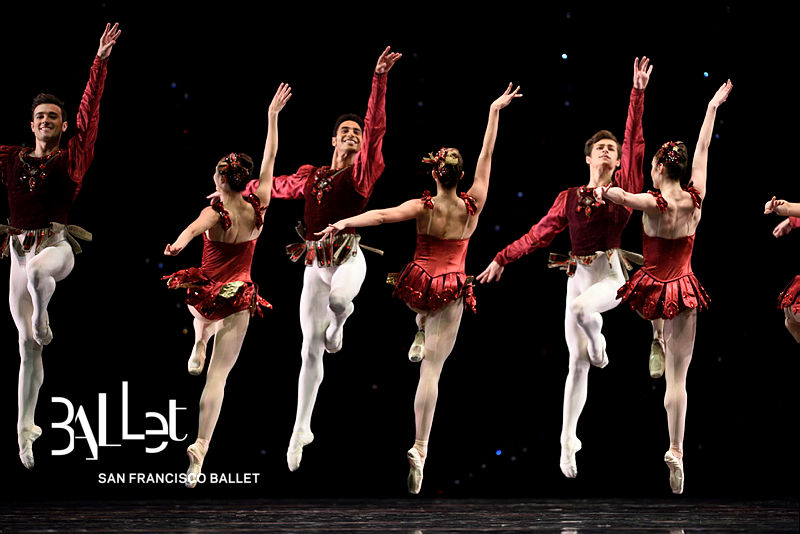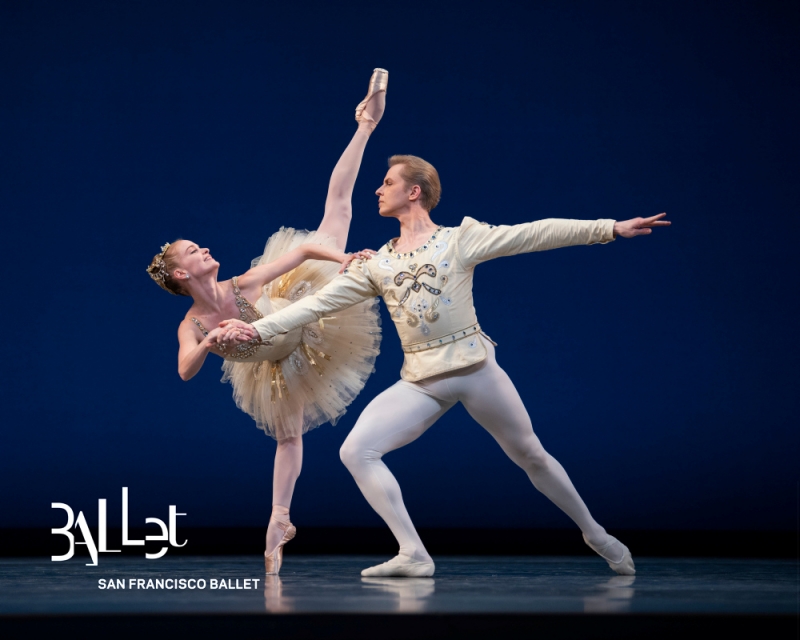Review: JEWELS at San Francisco Ballet Offers a Treasure Trove of Spectacular Dancing
Balanchine's dazzling masterwork is available for streaming through April 21st

The latest program in San Francisco Ballet's 2021 digital season is the glorious return of George Balanchine's Jewels. This tripartite masterwork is generally cited as the first full-length plotless ballet, which is a dubious claim depending on how you choose to define "full-length" or "plotless." It's also often been described as an exploration of the differences between the French, American and Russian styles of ballet, or a distillation of the intrinsic properties of emeralds, rubies and diamonds. Personally, I find those descriptions to be almost infuriatingly elusive and thus not at all helpful. So - here's all you really need to know going in: the whole thing is fabulous, and you really need to see it. And If you have seen it before, you need to see it again. It's the kind of complex work that just gets better with repeated viewings as you're bound to find new things to delight in that you hadn't noticed before.
That Jewels has so beautifully stood the test of time since its 1967 premiere is a bit of a surprise, given that it was created amidst an atmosphere of hype that was unheard of for City Ballet at that time, including a fashion spread with the leading ballerinas at Van Cleef & Arpels. Our cultural landscape is littered with countless "major" new works that were commissioned to much fanfare and premiered to mystified audiences only to never be seen again. Well, it turns out that Balanchine was not one to waste such a high-profile opportunity, and in this instance used it to create a ballet that is at once creative, quirky and deeply engaging on an emotional level.
Watching SFB's production, I was struck by the notion that for me the connective tissue between its three disparate ballets is that towards the end of each one, there is a distinctive, signature walking move that crystallizes the ethos of that particular piece. In Emeralds, it's a gentle, ambling stroll underpinned by a faint, rhythmic pulse that creates a subtle air of romantic longing. In Rubies, it's a jaunty jog with bent arms for the men and a spritely canter with straight arms and flexed wrists for the women that capture the antic, competitive spirit of that piece. In Diamonds, it's a stately grand promenade with an added little hitch kick as dozens of dancers flood the stage for the joyous finale.

Emeralds, captured here in a recent performance, gets Jewels off to a beautifully enigmatic start. The opening movement, set to Fauré's gorgeous Pelleas et Melisande Suite, reads as one extended, languorous sigh, sensitively danced by Angelo Greco, Misa Kuranaga and Sasha Mukhamedov. The pace picks up considerably with a spritely trio fabulously danced by a perfectly matched Esteban Hernandez, Wona Park and Julia Rowe. They are so wondrously in synch with each other that they are able to move as a single unit one moment, and the next break out into incisive, complementary solos. The ballet comes to a close with a slow, walking pas de deux for Mukhamedov and Aaron Robison, which captures the ballet's overriding spirit. Robison is particularly effective in this section, with his gallant manner and attentiveness to the underlying pulse of the music.

When the curtain rises again for Rubies, set to Stravinsky's astringent and energetic Capriccio for Piano and Orchestra, we are in a completely different world. Suddenly, everything is jaunty, angular and delightfully off-kilter. The music is full of unexpectedly quirky melodies and shifting rhythms that Balanchine treats like a fun house. Captured at an SFB performance from February 2016, the dancing is terrifically crisp throughout. A special shoutout here to the spirited corps of 12 who seem to be having a blast in nailing every difficult, unorthodox step. The opening section is led by Wanting Zhao, who dances with admirable clarity and speed, but perhaps wasn't yet comfortable enough with the brashness of the choreography to fully commit to it. In the years since, Zhao has really blossomed as a dancer and would now likely totally crush it. The main couple are a buoyant and playful Mathilde Froustey and Pascal Molat. They dance well together, but seem a bit miscast here. I wanted to see them dig in more, dance lower to the ground, and really go for the more competitive, rough-and-ready aspects of the movement.
After the idiosyncratic hijinks of Rubies, it can take a little while to adjust to the stately grandeur of the closing ballet Diamonds, set to Tchaikovsky's ravishing Symphony No. 3 in D Major. The opening movement for the corps women is merely pleasant and feels a bit indistinct. Soon, however, things snap into focus as Balanchine takes us through a progression of astonishing sequences that lead inexorably toward the effervescent finale. The second movement is an extended, 10-minute adagio for Sasha De Sola and Tiit Helimets, utterly bewitching from beginning to end even though it contains not a single particularly flashy move. Although this is ostensibly a plotless ballet, it seems to me that we are watching a mature couple work through a period of uncertainty or stasis in their relationship before regaining their connection to each other. It's fascinating to me how the woman here always seems in control of the situation, even as she is being lifted or held. It is so often she who moves away from him, and it is he who runs to catch up with her.

The dancing here between De Sola and Helimets is just flat-out phenomenal. They are both perfectly in tune with each other as they navigate each tiny shift in their relationship. I also love how they underplay the emotion and let the movement speak for itself. When he lifts her and carries her across the stage and sets her back down as softly as a caress, the effect is transcendent. The pas de deux ends in a gesture of tender yielding, a meeting of equals. No disrespect to all the other incredible dancers out there, but I don't think I'll see a more glorious 10 minutes of dance all year.
In the following scherzo movement, De Sola and Helimets finally have the chance to let loose with some fireworks. Helimets whips off a perfect series of turns a la seconde, and De Sola shows off her otherworldly ability to punctuate a passage of intricate, fast-moving footwork, with a sudden, heart-stopping balance on one toe. Diamonds then really takes flight when 32 dancers appear out of nowhere for the ebullient polonaise finale. How joyous it is to see so many terrifically talented dancers giving it all they've got in perfect synchronicity. It's a thrilling close, and lucky for us that it's been captured on video so that once it's over we can watch it all again, right away.

in the joyous ending to Diamonds
(All photos by Erik Tomasson)
San Francisco Ballet's production of Jewels is available for streaming through April 21, 2021. For further information and to purchase tickets, visit www.sfballet.org or call (415)865-2000.
Reader Reviews
Videos

